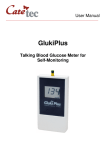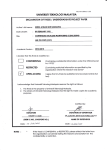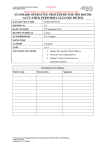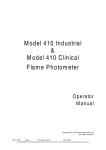Download User Guide - JNS Biomedical
Transcript
PACKAGE BEFORE USING THIS SYSTEM. IF YOU FIND ANY IMPERFECTION IN OUR PRODUCTS, PLEASE RETURN THE WHOLE SYSTEM TO THE PLACE OF PURCHASE. Blood Glucose Monitoring Syste m AC-300 AC-300, AC-301, AC-302, AC-303, AC-304, AC-30 5 Blood Glucose Meter Study this diagram and become familiar with all the parts of your GoodLife AutoCode AutoCode Series Blood Glucose Meter. ❶ ❺ User Guide About GoodLife Intended Use The GoodLife Blood Glucose Monitoring System is designed to quantitatively measure the level of glucose in capillary whole blood by people with diabetes or by healthcare professionals for monitoring blood glucose at home or in healthcare facilities. The device is indicated for professional use and over-the-counter sales. Principle of the Test The GoodLife System is an electrochemical biosensor system that measures the amount of electric current produced and displays the result as a blood glucose level. About the System The GoodLife System is designed to pursuit the accuracy in blood glucose monitoring to provide you with easy and comfortable testing. The system requires 0.5μL of blood sample and 5 seconds for the test to complete. The GoodLife System consists of: GoodLife Blood Glucose Meter GoodLife Blood Glucose Test Strips(AC, also known as ACH) GoodLife Check Strip GoodLife Glucose Control Solution (optional) Lancing Device (optional) Lancets (optional) These products are intended to be used together to get accurate blood glucose test results. Do not use other test strips or control solutions with your meter. Important Information The GoodLife System is intended for in vitro diagnostic use with capillary whole blood. The system should not be used for diagnosis of diabetes or for testing newborn infant (neonatal testing). CAUTION 1. The user should not take any medical relevance decision based on test result without first consulting his or her medical practitioner. 2. Call your doctor immediately if you experience symptoms that are not consistent with your blood glucose test results. 3. Severe dehydration or excessive water loss may cause false, high results. Call your doctor right away if you suspect you are suffering from dehydration. 4. A sample with large amount of reducing substances such as triglycerides (>11.3mmol/L), ascorbic acid (>0.13mmol/L), uric acid (>0.89mmol/L) and xylose (> 3.4mmol/L). 5. A red blood cell count (hematocrit) that is either very high (over 55%) or very low (under 30%) can cause false result. 6. High altitudes above than 2,750 meter (8,800 feet) may affect the test results. 7. Temperatures outside the range of 10°C to 40°C (50°F to 104°F) may affect the test results. NOTE: PLEASE MAKE SURE THAT ALL PRODUCTS LISTED ON THE “CONTENTS” OF THE BOX ARE CONTAINED IN THE ❹ Y ❷ ❻ ❸ Please read this User Guide before using your GoodLife Blood Glucose Meter (AC-300). If you have any questions or enquiries, please contact us or your local distributor. AC-300 ❶STRIP SLOT: Holds a Blood Glucose Test Strip or Check Strip in place when you perform blood glucose test or perform check test. ❷DISPLAY: The large, easy to read display shows the test results, messages, blood glucose results stored in memory, time and date. ❸BUTTON: Press button to enter date and time setting,or enter memory mode to recall the information stored in meter’s memory. ❹EJECTION BUTTON: For a easy ejection of the test strip. ❺Meter SN Label: The label shows the meter serial number. ❻BATTERY COMPARTMENT: Holds one 3V Lithium battery. Battery is not yet installed into meter when new purchasing. Before using the meter, please install the battery first. Meter LCD Window ⓬ ❻Y ❼ ❶ ❷ ❾ ❸ ❺ ⓫ ❹ ❽ ❿ ❶TEST RESULT ❷BATTERY SYMBOL: Appears when battery is low. ❸STRIP SYMBOL: Appears when the test strip is inserted and meter is ready for blood testing. Replace vial cap after removing test strips. DATE: Month/Day at the moment of the test. ❹ ❺CODE: Code appears to indicate code number. when ready to test. ❻ :Year at the moment of the test. ❼THERMOMETER SYMBOL: Appears when ambient temperature is above or below the acceptable range needed for testing. ❽mmol/L: Units of measure. :Memory capacity is 900 entries. The display shows ❾ to ensure that all digits are working properly. ❿TIME: 12 and 24 hour period format. ⓫ : Appears to indicate memory mode when reading previous results. SYMBOL: The test can be adjusted and stored into ⓬ 2 types of test modes - BEFORE A MEAL TEST ( ), and AFTER A MEAL TEST ( ). Blood Glucose Test Strip ❷ ❶ ❸ Glucose Control Solution. Results will not be accurate if used with plasma or serum samples. 3. Do not use test strips beyond the expiration date indicated on the strip vial label. 4. The discard date for test strips is 90 days after first opening the vial. Record the discard date on the vial when you open a new vial of test strips. 5. Blood Glucose Test Strip can be damaged by heat and light. Keep them sealed in the original vial. 6. Store the vial in a cool, dry place below to 40°C / 104°F and above 10°C / 50°F. Do not refrigerate. 7. Do not use damaged test strips in any way. Use test strip immediately after taking it out from the vial or foil packet; replace the vial cap and close it tightly. 8. Do not transfer test strips to a new vial. Always carry test strips in their original vial. 9. Do not place in direct heat or sunlight. 10. Do not carry loose test strips in your carrying case. 11. Test strips are for single use only. Glucose Control Solution (Optional) GoodLife Glucose Control Solution is used to check if the GoodLife Blood Glucose Meter and Test Strip are working correctly as a system. It can be used in two ways: practice the test procedure To To make sure that the GoodLife Blood Glucose Meter and Test Strips are working together properly. IMPORTANT INFORMATION 1. Do not use control solution beyond the expiration date indicated on the bottle label. 2. The discard date for control solution is 90 days after first opening. Record the discard date on the bottle when you open a new bottle of control solution. 3. Store the control solution closed at temperatures between 10ºC (50ºF) and 30ºC (86ºF). 4. Please carefully read the label before use. IMPORTANT TEST STRIP INFORMATION 1. GoodLife System measures the amount of glucose in capillary whole blood. Blood can be applied to the front of the test strip and is automatically drawn to the test strip through capillary action. 2. GoodLife Blood Glucose Test Strips are intended for in vitro diagnostic use with capillary whole blood or GoodLife 1. Wash your hands throughly with soap and warm water. Rinse and dry completely. Warm your fingers to increase blood flow. How to delete memory 1.Insert check strip into strip slot with label side up. 2.After “OK” displayed, press and hold the button for 3 seconds, the meter will display “dEL”, then press and hold the button for 2 seconds. Meter will display “OK” before turning off and all the memories have been deleted successfully. 3.Remove the check strip from the meter. 2. Take out new test strip from vial. Be sure to tightly replace vial cap after taking out test strips. Insert test strip immediately into strip slot as illustrated. The meter turns on automatically. Setting Meter Parameters Setting Time & Date When you first time installing the battery into the meter or when replacing a battery, the meter will automatically enter to the setting mode. Please set correct time and date before you begin testing. How to set time and date: 1.Press button to select the desired year. 2.After year is set ,allow it to flash for 3 times and shift to the next setting. 3.Repeat above steps to set the month, day, hour and minute by Button. 4.After minute is set, the meter will display “OK” before turning off. Prepare for Blood Sampling Adjustable Lancing Device Depth Selector 5 Depth Adjustment Cap 30 86 Perform Control Test 1. Insert a new test strip into the strip slot, the meter will activate. 2. The code number will appear on the screen. Compare the code number shown on the screen against the code number on the test strip vial. If the two numbers match, you may begin test, otherwise consult your local distributor. 3. Press button 3 times to choose Level1 control solution test (display “qCL“) or 4 times to Level2 control solution test (display “qCH“) 4. Gently shake the control solution and apply a drop to the aperture of strip. Make sure that the control solution has saturated the Blood Reaction Zone of the test strip. 5. Test result will show up in 5 seconds. The result should correspond to the range printed on the label of strip vial used. NOTE: REPEAT TEST IF THE RESULT FALLS OUTSIDE THE CONTROL RANGE. IF YOU CONTINUE TO GET THE RESULT FALLING OUTSIDE THE CONTROL RANGE, YOUR METER AND STRIP MAY NOT BE WORKING PROPERLY. DO NOT USE THE SYSTEM TO TEST YOUR BLOOD UNTIL YOU GET A TEST RESULT FALLS WITHIN THE CONTROL RANGE. CONSULT YOUR LOCAL DISTRIBUTOR FOR HELP. Check Strip ❶Aperture: apply the blood from the front of strip ❷Blood Reaction Zone: It must be filled with blood entirely. ❸Black Electrode End: insert this end of test strip into meter. NOTE: IF YOU DO NOT GET “OK” READING BUT APPEAR OTHER ERROR MESSAGE, TURN OFF THE METER BY REMOVE CHECK STRIP FROM THE METER. THEN CHECK THE BATTERY AND REPEAT THE TEST. IF THE SECOND RESULT PERSISTS, CONSULT YOUR LOCAL DISTRIBUTOR FOR HELP. GVAH Check Strip The Check Strip can be used in 2 ways: CHECK 1. To check that the meter is operating properly. Use when performing quality control check on your meter. 2. To delete all test memories. How to check meter by check strip 1. Insert the check strip into strip slot with label side up as above. 2. You should obtain an “OK“ reading within 10 seconds, which means your meter is working properly. 3. Remove the check strip to exit. Meter will automatically turn off. Lancet Holder Cocking Control Ejection Button Release Button Lancet Protective Cap IMPORTANT TEST STRIP INFORMATION 1. Lancet is for single use only. 2. Keep lancing device and lancets clean. 3. Be cautious when removing the used lancet from the device and when disposing the used lancet. 4. The lancing device and lancets are in conformity with MDD 93/42/EEC. Refer to product labels for contact information of manufacturer and CE marking. Set Lancing Device 1. Remove the depth adjustment cap. Insert a lancet into the lancet holder and push down until it is fully seated. 2. Twist off the protective cap until it separates from the lancet. 3. Replace the depth adjustment cap and set the puncture depth to the desired number. NOTE: THE SHORTER THE SCALE THE SHALLOWER THE PUNCTURE. 4. Pull back the cocking control until it makes a click, press release button for penetration. If it does not click, the device may have been cocked when the lancet was inserted. Please contact local distributor. Performing Blood Test 3. Check that the code number on the meter matches the code on the vial. If the 2 numbers are matched, you may begin blood testing, otherwise consult your local distributor. 2. Was the blood sample applied to the test strip immediately after the strip was removed from the vial? 3. Was the size of the blood sample sufficient? 4. Was the test strip vial cap tightly sealed? 5. Was the test strip used before the expiration date? 6. Were the test strips stored away from extreme temperatures or from areas of high humidity? Then run a quality control check with your GoodLife Glucose Control Solution and a new test strip. If the control test result is within the acceptable range, review testing procedure and repeat your blood glucose test with a new test strip. If your blood glucose value is still inconsistent with your previous results, contact your doctor immediately for help. 9 4. When the symbol flashes, you are ready to perform a test. 5. If the test is done in 2 hours of meal, press button to change the setting from to . 6. Hold the prepared lancing device firmly against the side of your finger. Press the release button. Gently massage your finger to obtain the required blood volume. To perform the test, you need 0.5uL of blood sample resting on your finger. Caution: To avoid the blood borne pathogen transmission, the lancing device is intended only for a single user and should not be shared. 7. Apply the blood sample to the front aperture of test strip in a way that is comfortable for you. Make sure that the blood drop has saturated the Blood Reaction Zone. When blood is applied to the strip, a count down appears on the screen until measurement is completed. 8. Test result will show up in 5 seconds. 9. Record your testing result in the log sheet, eject the strip from meter and discard the used strip and lancet safely in a puncture resistant container. 10. The testing range of the meter is from 1.1 to 33.3 mmol/L. If HI is displayed, your blood glucose result may be higher than 33.3 mmol/L. If LO is displayed, your blood glucose result may be lower than 1.1 mmol/L. Understanding Your Test Result Expected values for people without diabetes: Time of Day Expected Range, Non-diabetes Before Meal Less than 5.6 mmol/L After Meal Less than 7.8 mmol/L Source: American Diabetes, Association Position Statement, Diabetes Care Vol.35 (Suppl.1) P.S13 (2012). For diabetes patients, please consult your healthcare professional to find out your target blood glucose value. If your blood glucose result seems unusually high or low, or inconsistent with your previous results, check the following: 1. Does the code number on the test strip vial match the code number on the meter? Memory Recall The GoodLife Blood Glucose Meter can automatically store up to 900 results on both before a meal and after a meal . When recalling the results, each single result appears from the latest to the earliest with time and date. To recall Results Stored in Memory 1. Turn meter on by press button till you hear a beep sound. The first result displayed on the screen is your 30 days average before a meal test result. 2. Press button to view 30 days average after a meal and the single test record from the most recent latest to the oldest. 3. Please press the button for 2 seconds to turn off or put it aside for 3 minutes for auto shut down. NOTE: ANYTIME IN MEMORY MODE, YOU CAN PRESS BUTTON UNTIL YOU HEAR THE BEEP TO EXIT AND TURN OFF THE METER. Data Download (optional) Data can be transfered to the server or pc by RS232 cable line. Taking Care of Your Meter To Replace the Battery 1. Make sure the meter is turned off. 2. Place the meter face down on a flat surface.. ÌGLAC-3Ç !-Î 3. Slide battery compartment door open. 4. Remove the old battery and insert new CR2032 battery into the battery compartment. Be sure to align the plus (+) and minus (-) signs correctly. 5. Close the battery compartment door. Check to see that your meter is working. If it fails to turn on, the battery may has been inserted incorrectly. Remove the battery and reinsert it correctly. ÌGLAC-3Ç !-Î ÌGLAC-3Ç !-Î NOTE: EVERY TIME WHEN YOU REPLACE THE BATTERIES, THE METER WILL TURN ON AUTOMATICALLY AND ENTER TO THE TIME/DATE SETTING. PLEASE SET CORRECT TIME AND DATE BEFORE TESTING. CLEANING Clean the outside of the meter with a soft cloth, slightly dampened with water. Do not get moisture into the strip slot and data port. STORAGE AND HANDLING Keep your meter free of dust or water. Protect it from extreme temperature and humidity. CAUTION If the product is not used for longer periods of time, please remove the inserted battery in order to prevent damage caused by leaking battery. Please follow all the instructions on the User Guide while operating GoodLife Blood Glucose Meter. HMD BioMedical Inc. will not be responsible for any impairment occurred from NOT following the instructions. WARRANTY HMD BioMedical Inc. warrants to the original purchaser that this instrument will be free of defects in material and workmanship for 5 years from the date of original purchase. During the stated 5-year period, HMD shall, at no charge, replace a unit found to be defective with an equivalent or current version of the owner’s model. This warranty is limited to replacement due to defects in parts or workmanship. HMD shall not be required to replace any units which malfunction or are damaged due to abuse, accidents, alteration, misuse, neglect, maintenance by other than HMD, or failure to operate the instrument according to instructions. POST- SALE SERVICE If you have questions or request, please contact our service department at Australia Region JNS Biomedical Pty. Ltd. [email protected] Display Messages and Problem-Solving Guide When any of the following messages appears, there is a problem with your GoodLife Blood Glucose Meter or the way in which you are performing a test. These messages will help you to identify certain problems. If error messages appear that are not listed on the following pages, contact with your local distributor for help. Display Y Decription Display check Blood glucose result may be higher than 33.3 mmol/L. Blood glucose result may be lower than 1.1 mmol/L. Temperature is above or below the operating range of test strips. Battery is low. Action to Take If some parts of the display are not working. Contact your local distributor for help. Review proper testing procedure and perform a quality check with control solution. Repeat blood test, if “HI” still appears, call your doctor immediately. Review proper testing procedure and perform a quality check with control solution. Repeat test, if “LO” still appears, call your doctor immediately. The result you have obtained may not be accurate. Move to an area with temperature between 10ºC to 40ºC (50ºF - 104ºF). Do not artificially heat or cool the meter. Change battery immediately. Test strip unthe test with known or may Perform new test strip. be damaged. No responses when strip is inserted into the meter. No responses when blood sample is applied to the strip. Te s t s t r i p i s used or test was not performed correctly. Maybe: 1. B a t t e r y i s dead. 2.Wrong strip was inserted. 3.Meter is defective. Maybe: 1.Blood sample is not sufficient. 2.Meter is defective. Perform the test with a new test strip and follow the test procedure correctly. You have to: 1. Replace battery. 2. Insert the test strip correctly. 3. Contact us for help. You have to: 1. Repeat test with sufficient sample. 2. Perform Meter Check by inserting check strip. System Specification Keep away from sunlight 1. Assay Method: Electrochemical biosensor 2. Test Sample: Fresh Capillary Whole Blood 3. Calibrated Result: Plasma / Serum glucose 4. Sample Size: 0.5 μL 5. Measuring Time: 5 seconds 6. Measuring Range: 1.1 – 33.3 mmol/L 7. Acceptable Hematocrit Range: 30%-55% 8. Operating Temp. Range: 10°C~40°C(50°F~104°F) 9. Operating Relative Humidity: 20% - 80% RH 10 . Memory Capacity: 900 test results with time and date 11. Result Setting: Before a meal, After a meal and Control solution test setting Biological risks Please consult instructions for use In vitro diagnostic medical device. Use by /Expiry date Serial number Manufacturer Authorised representative in the European community This product fulfills the requirement of directive 98/79/EC in vitro diagnostic medical device The symbol indicating seperate collectionfor electrical and electronic equipment consists of the crossed-out wheeled bin. When the end-user wishes to discard this product, it must be sent to seperate collection facilities for recovery and recycling. By separating this product from other household-type waste, the volume of waste sent to incinerators or land-fills will be reduced and natural resources will thus be conserved. 12. Average Display: 30 days average 13. Power Supply: CR2032 Battery x 1 14. Battery Life: Approximately 1000 tests 15. Automatic shut-off: In 3 minutes 16. Meter Dimension: 90mm (L) x 45mm (W) x 15mm (H) 17. Weight: Approximate 50g (without battery) Performance Evaluations Precision Tests were carried by trained technicians in the laboratory setting. The venous whole blood from one subject was adjusted to 6 different levels. Strips out of a single lot were tested. The results are shown in the following table. Level No. of test I II III IV V VI 100 100 100 100 100 100 Mean (mmol/L) 2.3 5.6 6.9 12.0 18.9 29.9 Within-Run C.V. (%) 4.6 4.1 2.5 3.6 3.5 2.6 Accuracy Tests were performed at hospital by healthcare professionals and diabetic patients. Fresh capillary finger whole blood samples were tested with the GoodLife System; plasma samples from the subjects were tested with YSI Model 2300 Glucose Analyzer as reference. The results are shown in the following table. Slope 0.93 y-intercept 0.3 mmol/L Correlation Coefficient (R) 0.99 Number of tests 200 Range tested 1.8~24.7 mmol/L Glucose Concentration < 4.2mmol/L Within ± 0.3mmol/L Within ± 0.6mmol/L Within ± 0.8mmol/L 32/38 (84%) 38/38 (100%) 38/38 (100%) Glucose Concentration ≥ 4.2mmol/L Within ± 5 % Within ± 10 % Within ± 15 % Within ± 20 % 86/162 (53%) 138/162 (85%) 159/162 (98%) 161/162 (99%) NOTE: THE PRODUCT IS TESTIFIED BY A THIRD PARTY THAT IT DOESN’T INTERFACE WITH OTHER POSSIBLE ELECTROMAGNETIC WAVE. Batch code Temperature limitation / Store at Caution Do not reuse Distributed by : JNS Biomedical Pty. Ltd. Paramount Centre, Shop 4a, 108 Bourke Street, Melbourne Vic 3000, Australia ABN: 79 163 593 833 [email protected] HMD BioMedical Inc. No. 181, Minsheng St., Xinpu Township, Hsinchu 305, Taiwan FIA Biomed GmbH Rheiner Strasse 172, D-48282 Emsdetten, Germany 3K-02-160035 V1.4











